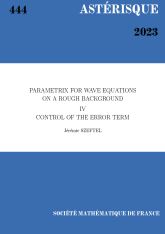Les opérateurs différentiels chiraux via la quantification du modèle sigma holomorphe
Chiral differential operators via quantization of the holomorphic $ \sigma$-model
- Consulter un extrait
- Année : 2020
- Tome : 419
- Format : Électronique, Papier
- Langue de l'ouvrage :
Anglais - Class. Math. : 81T15, 81T40, 81T70, 17B69, 55N34
- Nb. de pages : viii+210
- ISBN : 978-2-85629-920-3
- ISSN : 0303-1179 (print), 2492-5926 (electronic)
- DOI : 10.24033/ast.1121
Le système bêta gamma incurvé est un modèle sigma nonlinéaire de source une surface de Riemann et de cible une variété complexe $X$. Ses solutions classiques sont données par des cartes holomorphes de la surface de Riemann dans $X$. Les arguments physiques identifient son algèbre d'opérateurs avec une algèbre vertex connue sous le nom d'opérateurs différentiels chiraux (CDO) de $X$. Nous vérifions ces affirmations de manière mathématique en construisant et en quantifiant rigoureusement ce système en utilisant sur les techniques développées par Kevin Costello et le second auteur, combinant à la fois les outils de la renormalisation, le formalisme de Batalin-Vilkovisky, et les algèbres à factorisation. En outre, nous prouvons que l'algèbre à factorisation des observables quantiques du système bêta gamma courbé encode les gerbes d'opérateurs différentiels chiraux. En un sens, notre approche fournit une quantification par déformation pour les algèbres de vertex. Comme dans de nombreuses approches à la quantification par déformations, la géométrie formelle de Gelfand-Kazhdan joue un rôle clé. Nous commençons par construire une quantification du système bêta gamma à valeur un disque formel de dimension n. Il existe une obstruction à l'existence d'une quantification qui soit équivariante par rapport à l'action des champs de vecteurs formels sur le disque ; cette obstruction s'identifie naturellement à la première classe de Pontryagin de la cohomologie de Gelfand-Fuks. Toute trivialisation du cocycle d'obstruction donne ainsi une quantification équivariante vis-à-vis d'une extension de champs de vecteurs formels par les 2-formes fermées sur le disque. D'après les résultats cité ci-dessus, nous en déduisons naturellement une algèbre à factorisation d'observables quantiques, à laquelle est associée une algèbre de vertex qui s'identifie à l'algèbre vertex formelle de type beta gamma. Par ailleurs, nous introduisons une version de la géométrie formelle de Gelfand-Kazhdan adaptée aux algèbres à factorisation et nous vérifions que, pour une variété complexe munie d'une trivialisation de sa première classe de Pontryagin, l'algèbre à factorisation associée décrit l'algèbre vertex.


